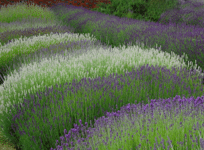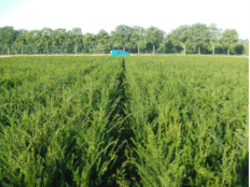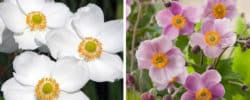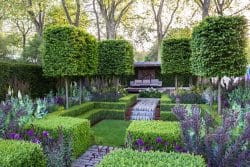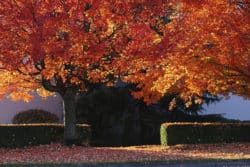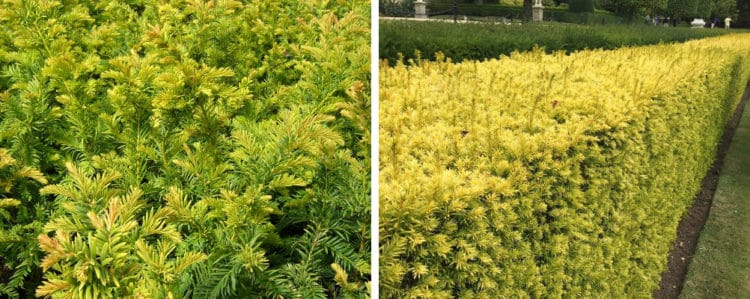What Are Ornamental Hedges?
Ornamental hedges are grown more for decorative purposes instead of practical ones. Small hedges therefore work perfectly as ornamental hedges, since they make for lovely borders in gardens and generally only need to be trimmed once a year, though you can trim them more frequently for a really sharp, formal appearance.
Small hedges are typically grown from slower growing hedging plants to create a hedge of 100cm or less. While many larger hedge plants such as Portuguese Laurel, Green Beech and Privet can be maintained at around a metre, there are times when small is beautiful and the slower growing nature of these plants is more appropriate.
Small hedges are usually grown from small leaved plants (so all is in proportion!) – the kind of plants that trim very neatly to produce immaculate little hedges by trimming several times a year if desired. All the small hedges on this page are of course easily maintained with a single trim each year and will still look great.
Benefits of Having Small Hedges
Small hedges are usually planted as decorative features within the garden rather than boundary hedges. They may be used to line paths, as is often the case with aromatic plants like Lavender or Sweet Box, which release their fragrance when they are brushed past.
Small hedges are a big feature of parterres and knot gardens, usually lining the edge of flower or vegetable beds. Their small size allows other plants to grow successfully around them and they do not obstruct the view. They are also small enough to step over, allowing easy access to the beds.
While the formal hedging designs of knot gardens generally use plain green hedging plants, more intricate designs often rely on a variety of foliage colours for contrast (and to great effect) such as the creamy splashed leaves of Variegated Box, the Silvery coloured Cotton Lavender or English Lavenders, the golden colour of Euonymus Emerald n’Gold, Japanese Holly Golden Gem or Lonicera Baggessons Gold. Other colours in small hedges can be achieved with Dwarf Purple Berberis, Pittosporum Golf Ball or Golden Ball and Photinia Little Red Robin.
Small hedges give definition and structure to the internal parts of the garden, particularly if evergreen species are selected. A prime example of this is the White Garden at Sissinghurst Castle Gardens in Kent where the narrowly clipped Common Box hedges delineate the beautifully planted borders while also acting as a foil for the plants within the beds at the same time.
Practical Considerations and Planting Tips for Small Hedges
Before you buy ornamental hedging plants, please consider:
- The type you want – evergreen, deciduous, flowering, native etc.
- The height you want to achieve and maintain
- The soil conditions in your garden, to ensure the species you choose could tolerate it
- How often you would be prepared to spend pruning
It’s important to consider whether the type of hedging you would like is suitable for your purposes – for example, evergreen hedges are better if you want more privacy, while deciduous hedges can be more forgiving to regular pruning.
Small hedges generally require more plants per metre of hedge to avoid gaps at the base, these being more noticeable in hedges of small stature. Therefore, the space you leave between small hedge plants is something to consider before you buy them – while we would generally suggest you leave plenty of space for them to grow, the spacing may need to be reduced in poor soils and difficult conditions.
Call or e-mail our team for their recommendations if you are unsure what kind of small ornamental hedge would be best.
 Bird Friendly Mixed Native Hedging
Bird Friendly Mixed Native Hedging Edible Mixed Native Hedging
Edible Mixed Native Hedging Flowering Mixed Native Hedging
Flowering Mixed Native Hedging Garden & Paddock Mixed Native Hedging
Garden & Paddock Mixed Native Hedging Gin Makers Mixed Native Hedging
Gin Makers Mixed Native Hedging Horse Friendly Hedging Plants
Horse Friendly Hedging Plants Pot Grown Mixed Hedging
Pot Grown Mixed Hedging Privacy Mixed Native Hedging
Privacy Mixed Native Hedging Species Rich Mixed Native Hedging
Species Rich Mixed Native Hedging Thornless Mixed Native Hedging
Thornless Mixed Native Hedging





